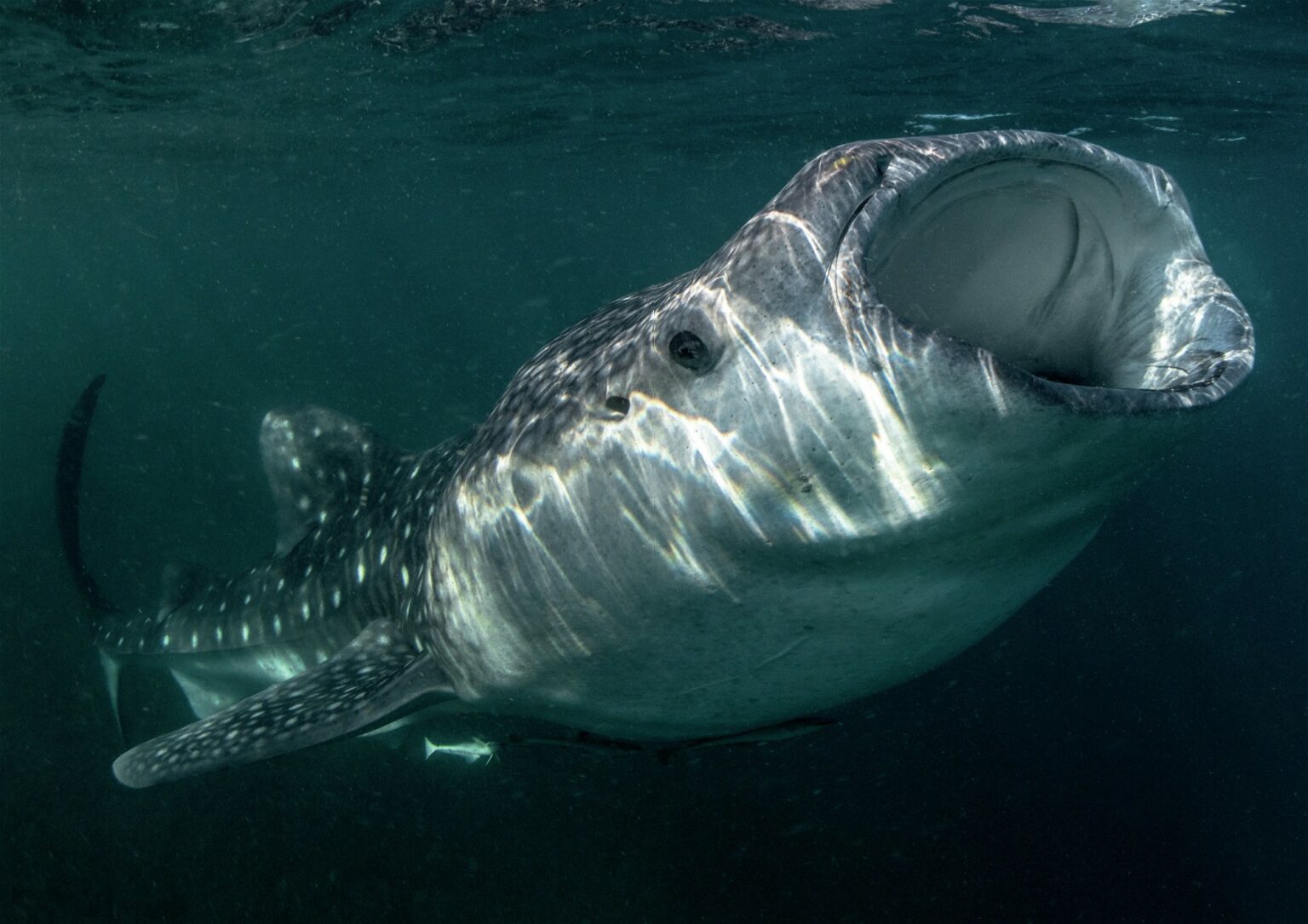Andrew Nieuwenhof explores the waters off Djibouti in search of the whalesharks which call this area home between November and February.
Photographs by David Robinson and Simone Caprodossi.
Welcome to Djibouti, which boasts one of Africa’s most arid and extreme coastal environments, yet here in this dry landscape, a very special annual underwater aggregation takes place. Between November and February, juvenile male whalesharks appear seemingly from nowhere to feed on the plankton-rich waters of the Gulf of Tadjoura. From nowhere?
“We have so many questions about these animals,” says Dr Jennifer Schmidt, one of two scientists leading our expedition. “Why do whalesharks come to Djibouti each year? Where do they come from and where do they go when they leave? Why is this particular population so much younger than other aggregations?”
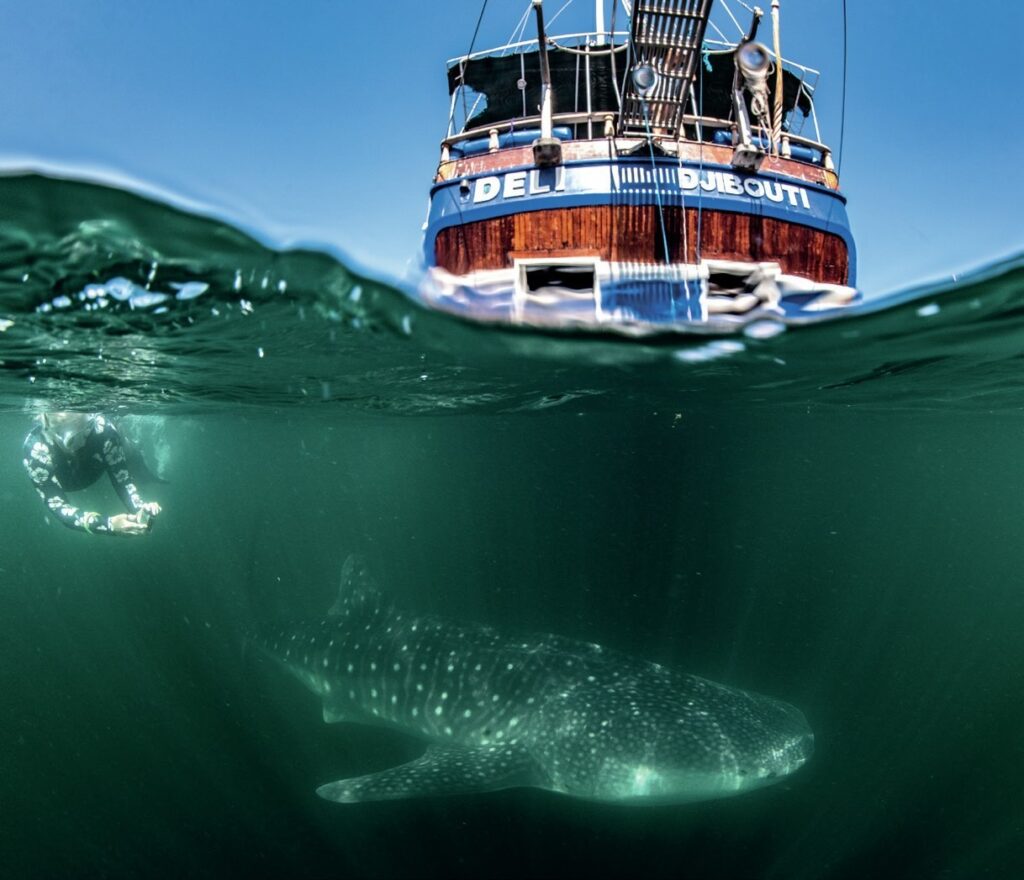
To try to answer these questions, Jennifer, the director of research at the Shark Research Institute in Princeton, US, Dr Ginevra Boldrocchi from the Università dell’ Insubria in Italy and Dr David Robinson, a marine ecologist and co-owner of Sundive Byron Bay, have been regular visitors to Djibouti. They are supported heavily by Moussa Omar Youssouf from the Centre d’etudes et de recherche de Djibouti and Dolphin Excursions Djibouti, who allow them to turn their beautiful wooden boat, The Deli, into a research boat for a week or two.
Jennifer and David worked closely for many years with the amazing research team at Marine Conservation Society Seychelles, led by Dr David Rowat, who first studied the whaleshark aggregation and brought it to global attention. Together they have helped to identify more than 730 whalesharks and tagged ten of them over 15 years.
“Despite this, what we don’t know is still much more than what we do know,” says David. On this 2022 expedition, David has brought along a team of 12 ‘Sundive honorary research assistants’ to help in their endeavours.
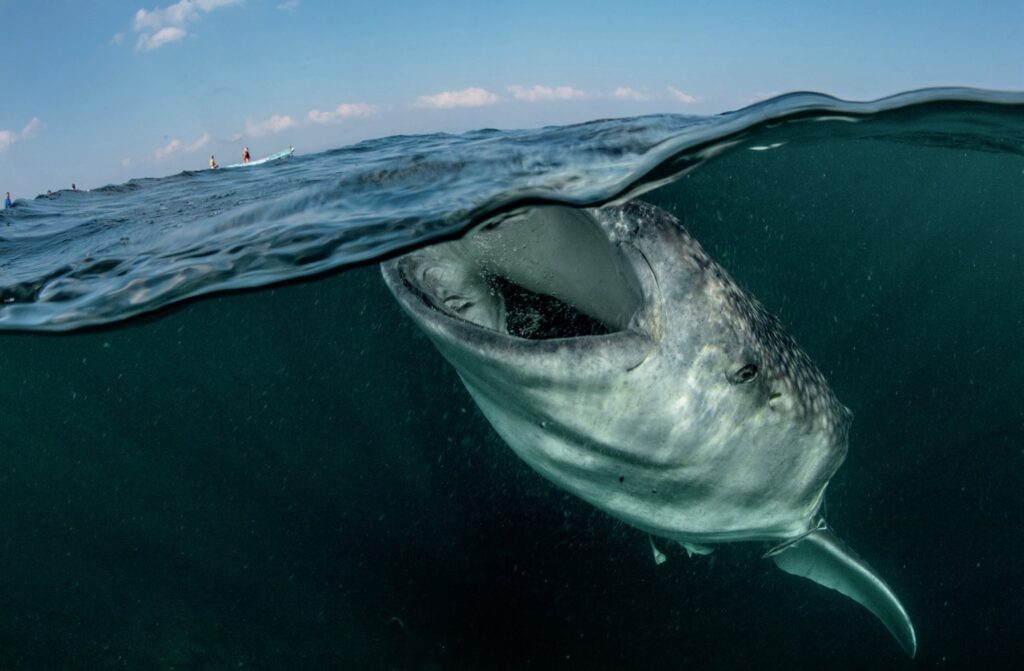
But where in the world is Djibouti? Hemmed in on the Horn of Africa by Somalia, Ethiopia and Eritrea, this former French colony sits on the Afar Triple Junction, where three of the Earth’s tectonic plates meet and is part of the Great Rift Valley of East Africa. The country is made up of dry coastal scrubland, inland desert and low-level salt flats and, a dramatic mountainous terrain.
It contains one of the world’s saltiest lakes, Lac Assal, the lowest point in Africa at 155 metres below sea level, which we visit before our expedition begins. Despite the conditions, land animals still call Djibouti their home such as baboons, gazelles, rock hyrax and many specialist desert animals including, of course, goats and camels. Many desertadapted birds also inhabit this volcanic landscape, such as the Djibouti francolin, one of the rarest birds in the world It is, however, under the water where the majority of the wildlife action happens.
Few, if any of us, had heard of the country before or knew exactly where it was. Our expedition there was a revelation. Before setting off, we were told there was no guarantee we would see any whalesharks, a bleak prospect considering the duration of the flight from Brisbane via Dubai to Djibouti. But any concerns were soon dispelled.
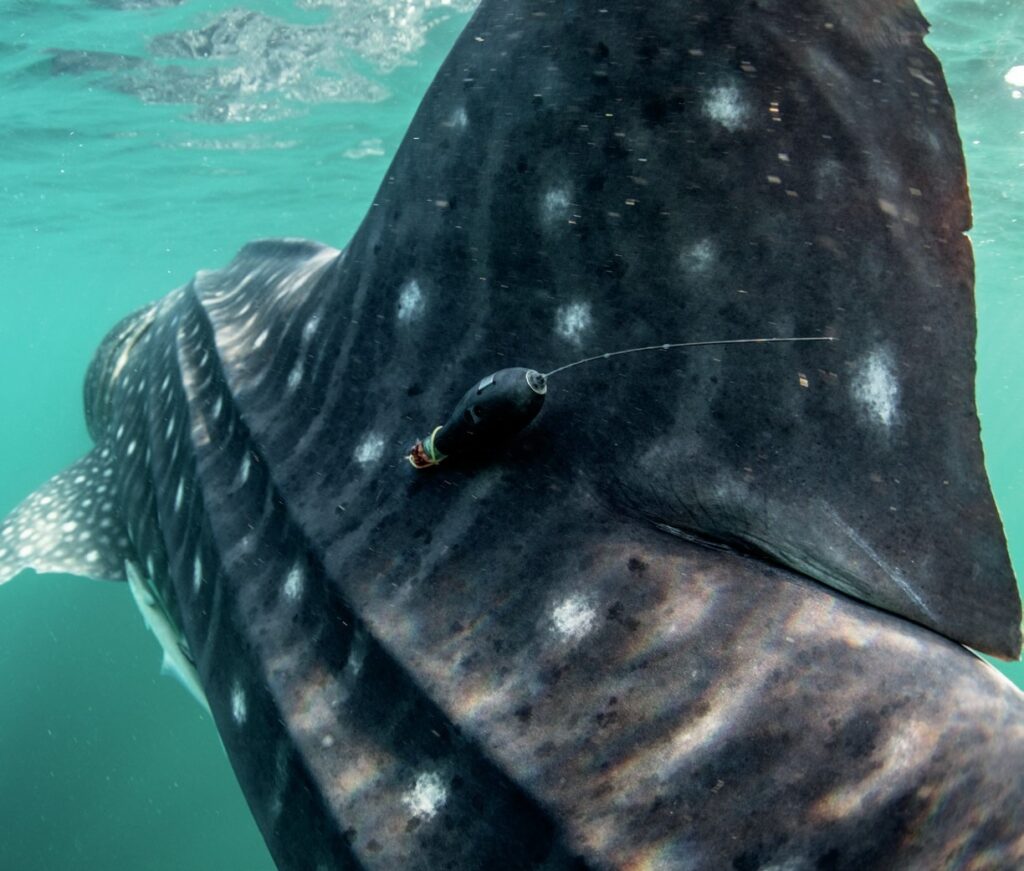
After a short stay in the capital, also called Djibouti, we are soon on board a classic 26-metre Turkish-made wooden schooner or gulet, The Deli. Leaving behind the hustle and bustle of the city and the crane-filled skyline of its port, we head west into the Gulf of Tadjoura, a basin of the Indian Ocean, 67 kilometres long and 26 kilometres wide. We are soon witnessing a dramatic shoreline landscape, mountains fringing both sides ripped apart by volcanic eruptions and tectonic plate movements. Great rift valleys give way to smaller rift valleys, towering mountain peaks, ramparts and parapets and other rocky structures of all shapes and sizes.
One shoreline cliff named Black Rock is more than just black, it’s pitch black. Approaching Devil’s Island in the Bay of Ghoubet is like crossing the River Styx in Dante’s Inferno. Etched into the island cliffs are haunting natural formations that seem to transform into bodies and faces melted by what seems like the doomsday heat of the Apocalypse; one figure could well have been the model for the painting, the Scream. At one end of Ghoubet, a red cliff comes into view, featuring a life-size rock formation called the Red Virgin.
Claims are made that the Planet of the Apes was filmed in these parts, but although it was not, it would have been a perfect location for the depiction of a futuristic planet. Despite this, there is beauty in the scenery and during our stay, we become captivated by the ever-changing panorama of the shoreline, especially at dawn and dusk.
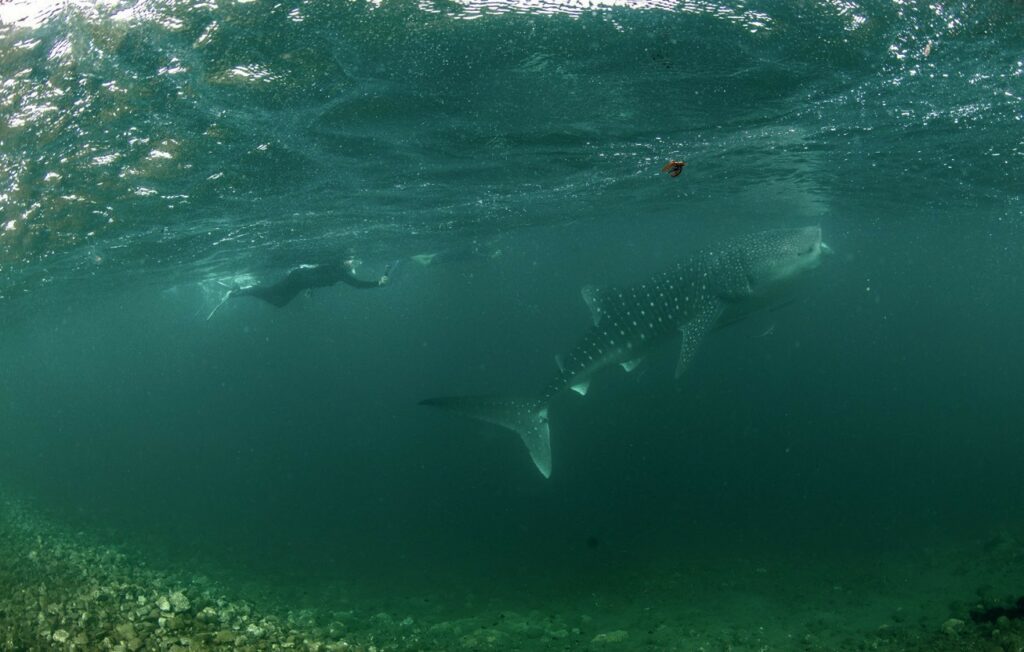
From close to shore, the Gulf plunges to a depth of 300m, from where nutrient-rich upwellings create plankton blooms which in turn attract these sharks. Once we drop anchor in our first bay, Ras Eiro, we set out in two skiffs and scan the waters for the tell-tale movements of the whalesharks’ caudal fins. On Day One, we encountered eight of them.
Although small compared to an adult that can grow to 20 metres, up close, the size of these youngsters is still impressive. The experience is breathtaking. One shark is vertical, gulping at the surface for its microscopic food, another is moving just below the surface, its huge mouth opening and closing, using its gill rakers as suction filters. With every encounter, we all use our cameras to film the distinctive spot and line patterns of the shark for identification, an easy task, given the sharks move slowly towards us, almost posing in co-operation.
“Djibouti hosts the youngest whalesharks of any known site, with an average size of just four metres, with some individuals as small as two metres, “ says Jennifer. “We know these juvenile whalesharks visit certain feeding aggregations on a recurring basis, and some sharks visit multiple different sites within a year. Less is known about what the sharks do when they are away from coastal feeding areas. Some move just offshore into deep water, some undertake regional migrations, while others may migrate across or between oceans.”
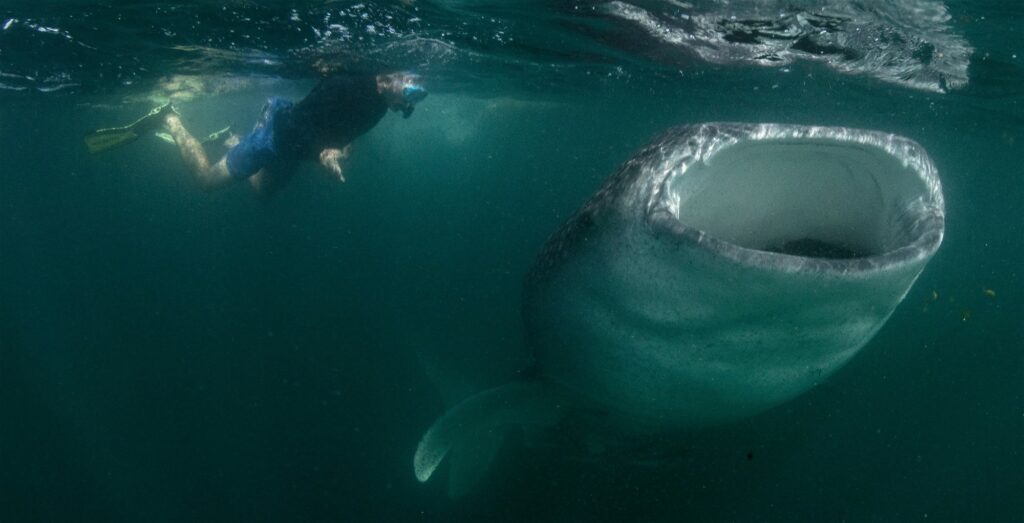
Most of our encounters occur off two beaches. While the only sign of human life we see on our whole trip is a few artisanal fishing boats, we notice a complex of huts and a lot of activity on Arta Beach, and we are told it is a training camp for the French Foreign Legion. Our second most popular spot is off Acacia Beach, which is a large tract of land at the foot of a rift valley that is covered in acacia trees. It is here, we occasionally spot a few gazelles.
It wasn’t all about whalesharks, however. Scuba diving was also available on the fringing reefs each day, with turtles and humpback dolphins a common sight. On one occasion we joined a pod of dolphins that approached our skiff and swam with them for nearly an hour. On another, trillions of anchovies appeared while we were in the water, swirling around us and finally separating like a curtain to reveal two whalesharks underneath. Back on our skiff, we witnessed dozens of birds dive-bombing into the bait ball and tuna jumping out of the water among them.
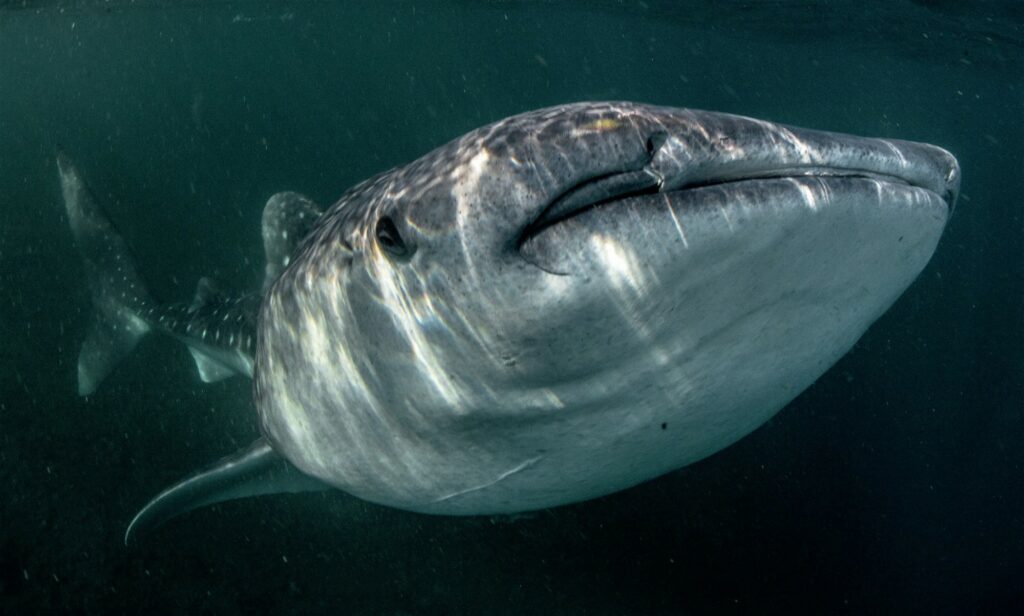
Another mindblowing experience was diving into the Crack, a tectonic plate fault line that separates Africa from Arabia. In low visibility five of us dive single file down very narrow rocky passages, at times pausing to touch the walls of both continents. Now and then weak beams of sunlight illuminate our path, revealing fan corals on the walls, and at one point, one of our divers looks up to see what he thinks is a leopard shark passing overhead.
On this trip, we encountered sharks every day, approximately 20 individuals in all. David and Jennifer successfully deployed four satellite tags for the project, which to our delight began transmitting almost immediately. Every day was filled with adventure and, most satisfyingly, whaleshark encounters.
Even on our last day, one shark turned up at The Deli, allowing us to snorkel around the boat with him for nearly two hours, a fantastic end to our Djibouti adventure.
“Ongoing data from these animals, and future expeditions, will help to reveal the mysterious lives of the world’s biggest shark.”, says Jennifer. Within a week of our return, one shark called ‘Steve’ had moved internationally and was transmitting from Somalia 204km to the south; We all look forward to following the sharks on their journeys.
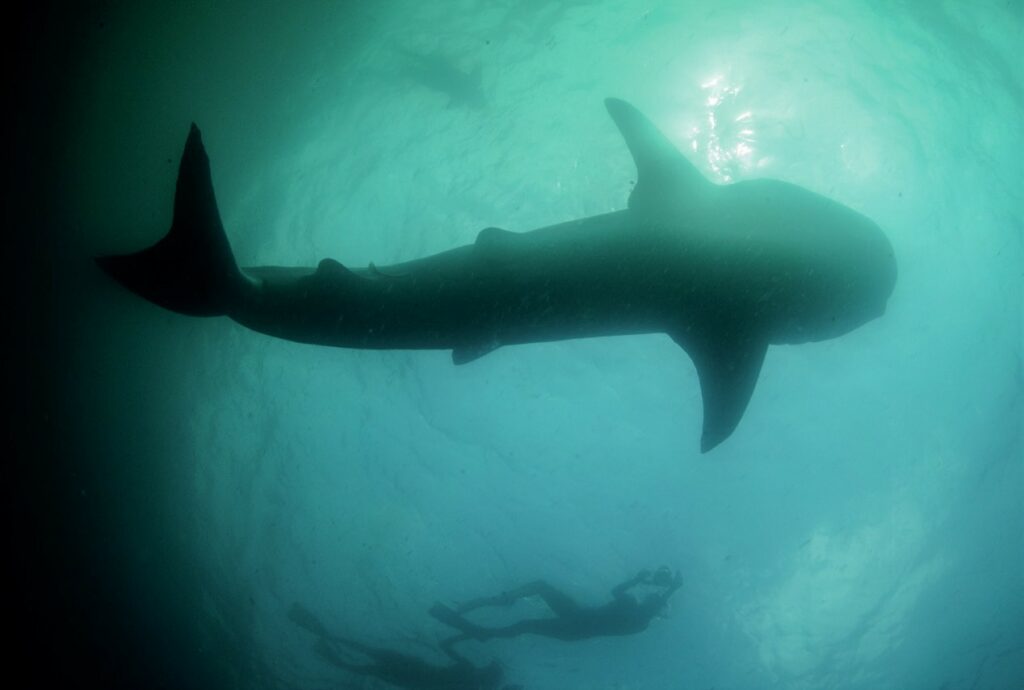
This article was originally published in Scuba Diver ANZ #55.
Subscribe digitally and read more great stories like this from anywhere in the world in a mobile-friendly format. Link to the article
